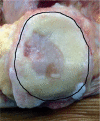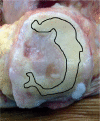Anterior knee pain following total knee replacement correlates with the OARSI score of the cartilage of the patella
- PMID: 24954482
- PMCID: PMC4105776
- DOI: 10.3109/17453674.2014.931198
Anterior knee pain following total knee replacement correlates with the OARSI score of the cartilage of the patella
Abstract
Background: Attempts to relate patellar cartilage involvement to anterior knee pain (AKP) have yielded conflicting results. We determined whether the condition of the cartilage of the patella at the time of knee replacement, as assessed by the OARSI score, correlates with postsurgical AKP.
Patients and methods: We prospectively studied 100 patients undergoing knee arthroplasty. At surgery, we photographed and biopsied the articular surface of the patella, leaving the patella unresurfaced. Following determination of the microscopic grade of the patellar cartilage lesion and the stage by analyzing the intraoperative photographs, we calculated the OARSI score. We interviewed the patients 1 year after knee arthroplasty using the HSS patella score for diagnosis of AKP.
Results: 57 of 95 patients examined had AKP. The average OARSI score of painless patients was 13 (6-20) and that of patients with AKP was 15 (6-20) (p = 0.04). Patients with OARSI scores of 13-24 had 50% higher risk of AKP (prevalence ratio = 1.5, 95% CI: 1.0-2.3) than patients with OARSI scores of 0-12.
Interpretation: The depth and extent of the cartilage lesion of the knee-cap should be considered when deciding between the various options for treatment of the patella during knee replacement.
Figures
Similar articles
-
Prevalence of anterior knee pain after patellar retention total knee arthroplasty: Comparison of patients with rheumatoid arthritis versus primary osteoarthritis.Acta Orthop Traumatol Turc. 2019 Nov;53(6):420-425. doi: 10.1016/j.aott.2019.07.001. Epub 2019 Aug 21. Acta Orthop Traumatol Turc. 2019. PMID: 31445793 Free PMC article.
-
Patella position is not a determinant for anterior knee pain 10 years after balanced gap total knee arthroplasty.Knee Surg Sports Traumatol Arthrosc. 2016 Aug;24(8):2656-62. doi: 10.1007/s00167-015-3930-z. Epub 2015 Dec 24. Knee Surg Sports Traumatol Arthrosc. 2016. PMID: 26704792
-
Role of Anatomical Patella Replacement on Anterior Knee Pain.J Arthroplasty. 2019 May;34(5):887-892. doi: 10.1016/j.arth.2019.01.011. Epub 2019 Jan 14. J Arthroplasty. 2019. PMID: 30712993
-
Different Factors Conduct Anterior Knee Pain Following Primary Total Knee Arthroplasty: A Systematic Review and Meta-Analysis.J Arthroplasty. 2018 Jun;33(6):1962-1971.e3. doi: 10.1016/j.arth.2017.12.024. Epub 2018 Jan 2. J Arthroplasty. 2018. PMID: 29398258
-
Patellar resurfacing in total knee arthroplasty for osteoarthritis: a meta-analysis.Knee Surg Sports Traumatol Arthrosc. 2011 Sep;19(9):1460-6. doi: 10.1007/s00167-010-1365-0. Epub 2011 Jan 14. Knee Surg Sports Traumatol Arthrosc. 2011. PMID: 21234539 Review.
Cited by
-
[Anterior knee pain after total knee arthroplasty : Causes, diagnosis and treatment].Orthopade. 2016 May;45(5):386-98. doi: 10.1007/s00132-016-3256-7. Orthopade. 2016. PMID: 27125231 Review. German.
-
Pressure algometry is a suitable tool to assess anterior knee pain in osteoarthritic patients.Eur J Orthop Surg Traumatol. 2019 Jul;29(5):1089-1093. doi: 10.1007/s00590-019-02391-w. Epub 2019 Feb 7. Eur J Orthop Surg Traumatol. 2019. PMID: 30734099
-
Systematic lateral retinacular release does not reduce anterior knee pain after total knee arthroplasty with patellar resurfacing.Knee Surg Sports Traumatol Arthrosc. 2023 Oct;31(10):4213-4219. doi: 10.1007/s00167-023-07456-2. Epub 2023 Jun 3. Knee Surg Sports Traumatol Arthrosc. 2023. PMID: 37270463 Clinical Trial.
-
Safety and Efficacy of 6.2 mm Patellar Button in Resurfacing Less than 20 mm Thin Patella: A Matched Pair Analysis.Knee Surg Relat Res. 2018 Jun 1;30(2):153-160. doi: 10.5792/ksrr.17.097. Knee Surg Relat Res. 2018. PMID: 29843200 Free PMC article.
-
Midterm survivorship and clinical outcome of INDUS knee prosthesis: 5 year followup study.Indian J Orthop. 2016 Mar-Apr;50(2):131-5. doi: 10.4103/0019-5413.177583. Indian J Orthop. 2016. PMID: 27053801 Free PMC article.
References
-
- Acebes C, Roman-Blas JA, Delgado-Baeza E, Palacios I, Herrero-Beaumont G. Correlation between arthroscopic and histopathological grading systems o... . Osteoarthritis Cartilage. 2009;17(2):205–12. - PubMed
-
- Agha RA, Webb B. A cadaveric investigation into the links between macroscopic and microsc... . Clin Anat. 2006;19(2):115–24. - PubMed
-
- Baldini A, Anderson JA, Zampetti P, Pavlov H, Sculco TP. A new patellofemoral scoring system for total knee arthroplasty . Clin Orthop. 2006;452:150–4. - PubMed
-
- Baldini A, Anderson JA, Cerulli-Mariani P, Kalyvas J, Pavlov H, Sculco TP. Patellofemoral evaluation after total knee arthroplasty. Validation of a... . J Bone Joint Surg (Am) 2007;89:1810–7. - PubMed
-
- Barrack RL, Wolfe MW, Waldman DA, Milicic M, Bertot AJ, Myers L. Resurfacing of the patella in total knee arthroplasty. A prospective, ra... . J Bone Joint Surg (Am) 1997;79(8):1121–31. - PubMed
Publication types
MeSH terms
LinkOut - more resources
Full Text Sources
Other Literature Sources
Medical
Miscellaneous




